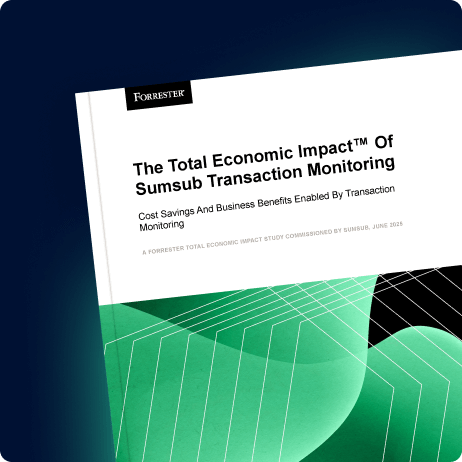- Jul 21, 2025
- 6 min read
10 Common Mistakes That Undermine In-House AML and Anti-Fraud Systems (and How to Avoid Them)
Learn about the most usual mistakes concerning AML and fraud systems and how to circumvent them effectively in 2025.

Spoiler: You’re probably making at least two of them right now.
Building your own anti-fraud or transaction monitoring system sounds like a no-brainer at first. You know your business. You’ve got the data. You’ve got the devs. How hard could it be?
Actually, it can be very hard, especially if you plan to scale, stay compliant, and actually not let the fraudster in.
We’ve talked to compliance teams, fraud analysts, and decision-makers across industries. And after compiling the Total Economic Impact™ (TEI) of Sumsub’s Transaction Monitoring solution, the patterns are crystal clear: companies that try to DIY their way through AML and fraud prevention encounter the same problems, again and again.
Check out the list—you might be making one or two of these mistakes. But no stress—there are things you can do in order to avoid making them, and functionalities that you can use within your systems to prevent possible headaches.
1. 🚧Mistaking “custom” for “effective”
Sure, your in-house tool is tailor-made… but does it work?
If you’re creating a custom in-house solution because you think ready-to-use solutions by third parties are less flexible and don’t fit you well, you are wrong. Making an in-house solution that works is remarkable; however, it’s important to acknowledge that you still operate within a specific jurisdiction and industry. Before creating your system check, keep in mind that many solutions are flexible enough to implement your craziest ideas.
That said, even the most customized in-house system can struggle to keep up with today’s fraud landscape. Fraud methods are constantly evolving, and fraudsters now have access to ready-made toolkits sold on the dark web—complete with fake documents, deepfake-ready selfies, and step-by-step guides tailored to different platforms. Static or overly rigid systems, no matter how custom-built, often can’t adapt fast enough. Sumsub’s research shows that 1 in every 100 users globally is linked to a fraud ring, involved in activities like mule recruitment or multi-accounting—threats that often slip past outdated or rule-heavy systems.
How to fix it: Before building from scratch, explore platforms that offer high flexibility. Many solutions support custom rules, workflows, and integrations, without the burden of internal development. The key is adaptability: your system should evolve as fast as fraud does.
Suggested read: Adaptive, Accurate, Efficient: How Dynamic Risk Scoring Elevates Compliance
2. 🧱Building on legacy infrastructure
You might be satisfied with your current infrastructure—and for now, it may seem stable. But systems age. Whether it’s in 5 years or 10, infrastructure upgrades are inevitable, and rarely simple. Migrating legacy AML and fraud systems comes with high costs, operational downtime, and often, limited internal continuity, especially as teams change and documentation ends up scattered across tools, folders, or people’s inboxes.
And when the time comes to update, you may find that your well-functioning system is now blocking innovation. Legacy tools, particularly static rules-based ones, are notorious for high false-positive rates (up to 95% in some industries) draining analyst time and making it harder to spot real threats.
How to fix it: Future-proof your fraud stack. Look for modular, API-first platforms that evolve with your business and reduce long-term technical debt. The goal isn’t just to replace, it’s to grow without rebuilding every few years.
3. 🕵️Over-relying on manual reviews
Manual review might feel safe, controlled, and human, but it’s also where most fraud slips through the cracks or gets flagged too late. For example, merchants manually screen 10–26% of orders, and that’s expensive. Reviewing every flagged transaction eats up time and labor and greatly increases the time per review.
Plus, overburdened analysts cost money. For example, Rise faced challenges with long wait times and extensive manual verification, resulting in errors, false positives, and numerous customer support tickets. After switching to Sumsub, it reached a 94% approval rate with a fully automated verification process.
How to fix it: Don’t be like Frank. Automate what’s automatable. Let humans handle edge cases, not every minor alert.
Suggested read: KYC Verification: Full Guide to Know Your Customer Compliance (2025)
4. 🐢Slow deployment
Bad actors innovate in days. Your anti-fraud rules and products? Weeks, if your devs are even available. New fraud scheme? Boom, you’ve lost your money. Fraud Intelligence is not just a trend, it’s a must for proactive defence.
Fraud becomes more and more complex, and fast—sometimes, your upgrades can’t keep up. A good example is the Marriott data breach, where attackers accessed between 300 and 500 million customer records through unpatched software on the Starwood network. The root cause was outdated software that had not received security updates, allowing hackers to infiltrate the system and exfiltrate vast amounts of data.
In-house tools often require hardcoding every change, meaning by the time you respond to one threat, five new ones are already knocking.
How to fix it: Choose or make solutions that support agile product evolution, from fraud detection logic to rule integrations and workflows. Real-time data feeds, built-in fraud intelligence, and fast configuration cycles mean you’re not waiting on a dev sprint to stay protected.
5. 💸Hidden costs drain your ROI
Building in-house feels cheaper—until you account for everything.
Developer hours. Compliance audits. Training. Maintenance. Missed alerts. Fines. Operational fatigue.
The TEI report shows how one Sumsub client achieved a 272% ROI over three years, in part by slashing operational costs and eliminating 3rd-party patchwork tools.
How to fix it: Look beyond initial costs—calculate long-term value.
6. 🔍Lack of cross-channel visibility
Your team is monitoring crypto, cards, and wire transfers—but are they seeing the whole picture?
Homegrown systems often operate separately. That means your AML team might have a blind spot for a fraud pattern that started three departments over.
How to fix it: Use dashboards that combine all types of transactions and link analysis tools, KYC data, and behavioral signals. It would be best if it all resided in one case management hub.
7. 🧠No AI = No chance
The global average fraud rate saw an increase from 2.0% to 2.6% in 2025, thanks to emerging threats like deepfakes and coordinated “fraud-as-a-service” attacks. Fraudsters are using AI. In 2025, AI is everywhere—for example, deepfakes now account for 7% of global fraudulent activity. If your tools aren’t, you’re playing chess without a queen. At this point, AI isn’t optional.
AI transforms AML and transaction monitoring by making systems more accurate, efficient, adaptive, and capable of real-time risk assessment—addressing many limitations of traditional legacy systems. Industry surveys show that AI adoption in the financial sector is driving measurable improvements in operational efficiency.
Sumsub’s new AI‑assisted Case Management platform, including tools like the AI assistant Summy, helped reduce false positives and prioritize high‑risk cases.
How to fix it: Add machine learning and AI to your fraud fighting—not just for detection, but for triage, scoring, and flagging hidden patterns.
8. 📊Compliance gaps creep in unnoticed
Regulations evolve constantly. Just in November 2024, regulators tightened tech‑support scam enforcement after US losses hit over $175 million among victims aged 60+. If your system can’t keep up, you’re risking hefty fines—or worse, license suspension.
In-house setups are less efficient at keeping audit logs clean, reports up-to-date, and workflows aligned with the latest AML directives.
How to fix it: Use platforms that are compliant across multiple jurisdictions and offer built-in compliance checks, automated reporting, and audit-ready workflows.
9. 🤹Too many cooks in the (data) kitchen
In-house tools often suffer from messy ownership: developers build them, risk teams use them, compliance tweaks them, and no one owns the outcome. Platforms often use different vendors for transaction monitoring, audits, reports, and other necessary tools for fraud prevention, and what’s worse, they try to marry them all.
This can create a lot of chaos, and it leads to duplicated work, broken logic chains, and finger-pointing when something goes wrong.
How to fix it: Use centralized, role-based systems where everyone works in sync, with proper access control and case handoffs. The best solution is one platform that has all the tools you need to secure the entire journey.
10. 📉Lack of data feedback loops
Many homegrown AML and anti-fraud systems are one-directional: alerts are reviewed, decisions are made, and that’s it. There’s no mechanism to feed outcomes (true positives, false positives, missed fraud) back into the system. As a result, the detection logic doesn’t evolve, even as fraud tactics do.
This stagnation leaves teams chasing yesterday’s fraud patterns while fraudsters move on. Effective teams use feedback loops to constantly refine detection. Every alert, decision, and investigation outcome is logged, analyzed, and used to retrain models or update rules, creating a virtuous cycle of continuous improvement.
How to fix it: Invest in platforms that let you build, test, and iterate detection logic with continuous performance tracking.
You don’t need to reinvent the wheel—just drive smarter
In-house systems can work for small, static operations. However, if you’re growing, looking to scale to new markets, regulated and AML-obliged, or facing a surge in fraud attempts, the cost of clinging tightly to DIY tools quickly outweighs the benefits.
Maintaining AML compliance is becoming increasingly daunting—especially as regulators in 2025 ramp up expectations around enhanced due diligence, beneficial ownership, and alternative payments. With $4.5 billion in fines issued globally last year alone, compliance has never been more complex or more critical.
Want proof?
Read the full TEI report to see how Sumsub’s Transaction Monitoring helped a real-life company cut alert resolution time by 75%, eliminate 3rd-party dependencies, and achieve a 234% ROI in just 3 years.
Because the real mistake might be thinking your in-house system is “good enough.”
Relevant articles
- Article
- 1 week ago
- 3 min read
Why is fraud thriving in some countries and on the decline in others? Sumsub’s Global Fraud Index gives exclusive insights by exploring the condition…

- Article
- Sep 18, 2025
- 6 min read
Learn what payroll fraud is, common schemes, red flags, and the best ways to prevent it in 2025.



